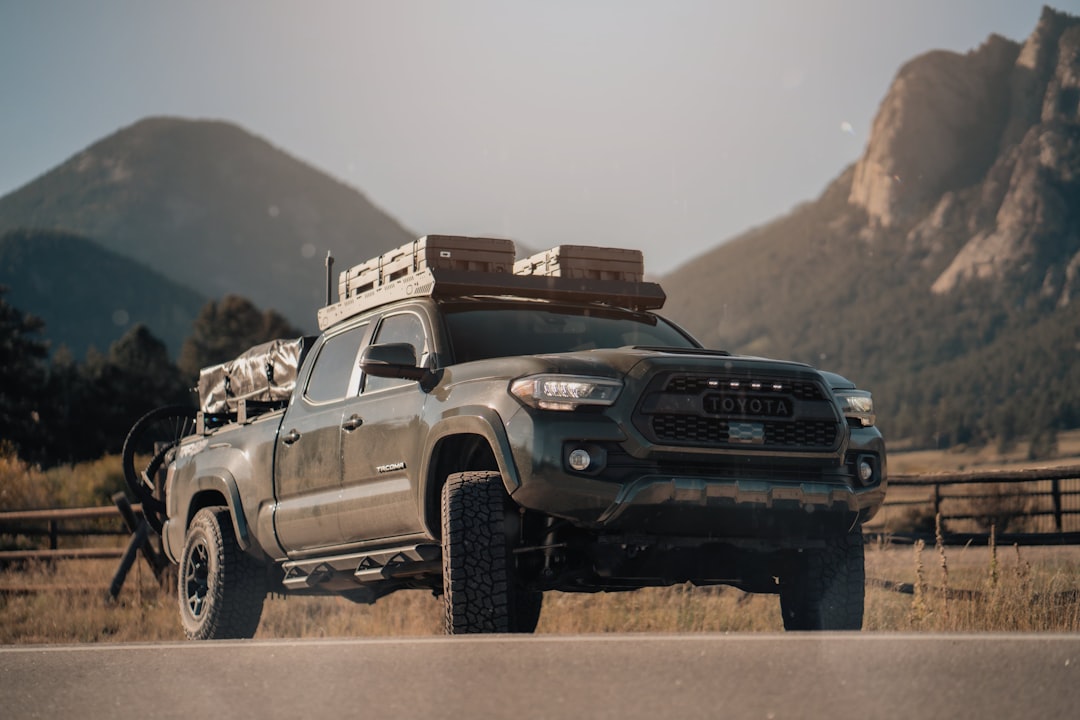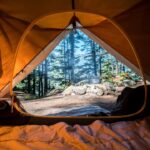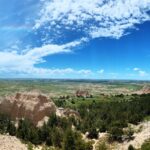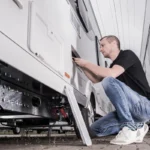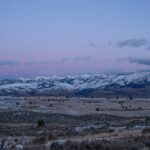Overlanding is a popular outdoor activity that combines elements of camping, hiking, and off-roading. It involves traveling long distances in a self-sufficient manner, often in a 4×4 vehicle, to explore remote and rugged areas. Overlanding allows individuals to immerse themselves in nature, disconnect from technology, and experience the thrill of adventure. In today’s fast-paced and technology-driven world, outdoor activities like overlanding are becoming increasingly important for our physical and mental well-being.
What is Overlanding and How it Differs from Other Outdoor Activities
Overlanding can be defined as a self-reliant journey to remote destinations, typically lasting for an extended period of time. Unlike traditional camping or hiking trips, overlanding involves traveling long distances and exploring multiple locations along the way. It often requires a specialized vehicle that is capable of handling off-road conditions and carrying all the necessary gear and supplies.
While camping and hiking are focused on staying in one location or traversing a specific trail, overlanding is about the journey itself. It allows individuals to explore vast landscapes, encounter diverse wildlife, and experience different cultures. Overlanding offers a unique blend of adventure, freedom, and self-sufficiency that sets it apart from other outdoor activities.
The Benefits of Overlanding: Why You Should Try It
There are numerous benefits to trying overlanding as an outdoor activity. Firstly, it provides both physical and mental health benefits. The physical aspect of overlanding involves being active, setting up camp, and exploring new areas on foot. This can improve cardiovascular health, increase strength and endurance, and boost overall fitness levels. Additionally, spending time in nature has been proven to reduce stress levels, improve mood, and enhance mental well-being.
Overlanding also offers the opportunity to explore new places and discover hidden gems that are off the beaten path. It allows individuals to escape the crowds and experience the beauty of remote and untouched landscapes. Whether it’s driving through rugged mountain ranges, camping on secluded beaches, or witnessing breathtaking sunsets in the desert, overlanding provides a sense of adventure and discovery that is hard to replicate in other outdoor activities.
Furthermore, overlanding allows individuals to disconnect from technology and embrace a simpler way of life. In today’s digital age, we are constantly bombarded with notifications, emails, and social media updates. Overlanding provides a chance to escape the noise and distractions of everyday life and reconnect with nature. It allows individuals to switch off their devices, enjoy the present moment, and truly immerse themselves in the beauty of their surroundings.
The Essential Gear and Equipment for Overlanding
| Item | Description | Quantity |
|---|---|---|
| Tent | A durable and waterproof shelter for sleeping and protection from the elements. | 1 |
| Sleeping bag | A warm and comfortable sleeping bag for a good night’s rest. | 1 |
| Camp stove | A portable stove for cooking meals and boiling water. | 1 |
| Cooler | A cooler for storing food and drinks. | 1 |
| Water filter | A water filter for purifying water from natural sources. | 1 |
| First aid kit | A first aid kit for emergencies and injuries. | 1 |
| Recovery gear | Tools and equipment for recovering a stuck vehicle, such as a winch, tow straps, and a shovel. | 1 set |
| Navigation tools | Maps, compass, and GPS for navigating off-road terrain. | 1 set |
| Communication devices | Two-way radios or satellite phones for communication in remote areas. | 1 set |
| Vehicle maintenance tools | Basic tools for maintaining and repairing the vehicle, such as a tire repair kit, jumper cables, and a basic tool kit. | 1 set |
To embark on an overlanding trip, there are several essential gear and equipment items that you will need. Firstly, you will need a suitable vehicle that is capable of handling off-road conditions. This could be a 4×4 truck, SUV, or even a modified camper van. It’s important to choose a vehicle that has good ground clearance, sturdy tires, and sufficient storage space for all your gear.
In terms of camping gear and supplies, you will need a tent or rooftop tent, sleeping bags or sleeping pads, cooking equipment, food and water supplies, and basic toiletries. It’s important to pack lightweight and compact items that are easy to transport and set up at each campsite. Additionally, you will need navigation tools such as maps, a compass, and a GPS device to help you navigate through remote areas.
Planning Your Overlanding Trip: Tips and Tricks
Before embarking on an overlanding trip, it’s important to do thorough research and planning. Start by researching different routes and destinations that you would like to explore. Consider factors such as weather conditions, road conditions, and the availability of campsites or accommodations along the way. It’s also important to check if any permits or licenses are required for the areas you plan to visit.
Create a detailed packing list to ensure that you have all the necessary gear and supplies for your trip. Divide your list into categories such as camping gear, cooking equipment, clothing, and personal items. This will help you stay organized and ensure that you don’t forget anything important. It’s also a good idea to pack some emergency supplies such as a first aid kit, a fire extinguisher, and a roadside emergency kit.
Lastly, it’s important to prepare for emergencies and unexpected situations. Make sure you have a plan in place for communication in case of emergencies, especially if you will be traveling in remote areas with limited cell phone reception. Consider investing in a satellite phone or a two-way radio for reliable communication. It’s also a good idea to familiarize yourself with basic first aid and emergency response techniques.
Finding the Best Overlanding Routes and Destinations

There are numerous overlanding routes and destinations to choose from, depending on your preferences and location. In North America, some popular overlanding routes include the Trans-America Trail, the Pacific Coast Highway, and the Alaska Highway. These routes offer stunning scenery, diverse landscapes, and opportunities for wildlife sightings.
If you’re looking for more unique destinations for overlanding, consider exploring national parks, state parks, or even international locations. National parks such as Yellowstone, Yosemite, and Banff offer incredible natural beauty and opportunities for outdoor adventure. International destinations such as Iceland, Australia, and South Africa are also popular choices for overlanding due to their diverse landscapes and unique wildlife.
When searching for off-the-beaten-path locations for overlanding, it’s important to do thorough research and connect with local communities or experienced overlanders. They can provide valuable insights and recommendations on hidden gems that may not be well-known to the general public. Online forums and social media groups dedicated to overlanding are great resources for finding insider tips and recommendations.
Safety Precautions and Emergency Preparedness for Overlanding
Safety should always be a top priority when engaging in overlanding. It’s important to have the necessary safety equipment and to be prepared for emergencies. Some essential safety equipment for overlanding includes a fire extinguisher, a first aid kit, a recovery kit (including a tow strap, shackles, and a winch), and a basic tool kit.
It’s also important to have basic first aid and emergency response training. This includes knowing how to administer CPR, treat minor injuries, and respond to common emergencies such as vehicle breakdowns or accidents. Consider taking a first aid course or wilderness survival training to enhance your skills and knowledge.
Communication devices are crucial when traveling in remote areas where cell phone reception may be limited or non-existent. Invest in a satellite phone or a two-way radio to ensure reliable communication in case of emergencies. It’s also a good idea to share your travel plans with someone you trust and to check in with them regularly to let them know you’re safe.
Overlanding with a Group: Pros and Cons
Traveling with a group can enhance the overlanding experience in many ways. Firstly, it provides an opportunity for social interaction and companionship during the trip. Sharing the journey with like-minded individuals can create lasting memories and foster new friendships. It also allows for shared responsibilities such as cooking, setting up camp, and navigating, which can make the trip more enjoyable and less stressful.
However, there are also challenges associated with group travel. Differing opinions on routes, destinations, or daily activities can lead to conflicts or disagreements within the group. It’s important to have open communication and compromise when making decisions as a group. Additionally, traveling with a larger group may require more planning and coordination in terms of logistics, accommodations, and supplies.
To ensure successful group overlanding, it’s important to establish clear expectations and guidelines from the beginning. Discuss and agree upon important factors such as driving responsibilities, campsite setup, and daily schedules. It’s also a good idea to assign specific roles or tasks to each member of the group to ensure that everyone contributes and feels involved.
Overlanding Solo: Tips for a Successful Trip
While traveling with a group can be enjoyable, there are also many benefits to embarking on a solo overlanding trip. Solo travel allows for complete freedom and flexibility in terms of route planning, daily activities, and decision-making. It provides an opportunity for self-reflection, personal growth, and increased self-confidence.
However, solo overlanding also comes with its own set of challenges and safety considerations. It’s important to take extra precautions when traveling alone, especially in remote areas. Inform someone you trust about your travel plans and check in with them regularly. It’s also a good idea to avoid traveling at night and to stick to well-traveled routes or popular camping areas.
When planning a solo overlanding trip, it’s important to research the areas you plan to visit and familiarize yourself with local customs, laws, and regulations. Consider joining online communities or forums dedicated to solo overlanding to connect with other solo travelers and gain valuable insights and recommendations.
Overlanding with Pets: How to Keep Your Furry Friends Safe and Happy
Many people enjoy overlanding with their pets as it allows them to share the adventure with their furry friends. However, it’s important to take certain precautions to ensure the safety and well-being of your pets during the trip.
Before embarking on an overlanding trip with your pet, make sure they are comfortable with car travel. Take them on shorter trips beforehand to get them used to being in the vehicle for extended periods of time. Ensure that your pet is up-to-date on vaccinations and has a collar with identification tags in case they get lost.
When packing for your pet, make sure to bring their food, water, and any necessary medications. Pack their favorite toys or blankets to provide them with a sense of familiarity and comfort. It’s also important to bring a leash or harness for walks and to keep them secure at campsites.
During the trip, make sure to provide your pet with plenty of water and regular breaks for exercise and bathroom breaks. Be mindful of the temperature and avoid leaving your pet in a hot vehicle. It’s also important to clean up after your pet and dispose of waste properly to minimize environmental impact.
Overlanding and Sustainability: How to Minimize Your Impact on the Environment
As outdoor enthusiasts, it’s important for us to minimize our impact on the environment when engaging in activities like overlanding. Responsible travel practices can help preserve natural landscapes, protect wildlife habitats, and support local communities.
One of the key ways to minimize environmental impact during overlanding is by practicing Leave No Trace principles. This includes packing out all trash, disposing of waste properly, and leaving natural areas as you found them. Avoid driving off designated roads or trails to prevent damage to vegetation and wildlife habitats.
Supporting local communities and conservation efforts is another important aspect of sustainable overlanding. Choose accommodations, restaurants, and shops that are locally owned and operated. Purchase locally made products or souvenirs to support the local economy. Consider volunteering or participating in conservation projects in the areas you visit.
Lastly, it’s important to educate yourself and others about the importance of responsible travel. Share your experiences and knowledge with others through social media, blogs, or community events. Encourage others to practice sustainable travel habits and be mindful of their impact on the environment.
Overlanding is a thrilling and rewarding outdoor activity that allows individuals to explore remote areas, disconnect from technology, and immerse themselves in nature. It offers numerous physical and mental health benefits, as well as the opportunity to discover new places and challenge oneself. By following proper planning, safety precautions, and sustainable travel practices, overlanding can be a fulfilling and enjoyable experience for outdoor enthusiasts of all ages. So why not give overlanding a try and embark on your own adventure? You may just discover a new passion for exploring the great outdoors.
If you’re interested in overlanding and also enjoy outdoor yoga and mindfulness retreats, then you’ll love this article on “Outdoor Yoga and Mindfulness Retreats in Nature.” It explores the benefits of practicing yoga and mindfulness in the great outdoors, allowing you to connect with nature while finding inner peace. Check it out here!
FAQs
What is Overlanding?
Overlanding is a type of self-reliant travel that involves driving or traveling in a vehicle over long distances, often through remote and rugged terrain.
What kind of vehicles are used for Overlanding?
Overlanding can be done in any type of vehicle, but most commonly, people use 4×4 vehicles, SUVs, or trucks that are equipped with off-road capabilities.
What equipment is needed for Overlanding?
The equipment needed for Overlanding varies depending on the type of trip and the terrain being traveled. Some common equipment includes camping gear, cooking supplies, water storage, navigation tools, and recovery gear.
Where do people go Overlanding?
Overlanding can be done anywhere in the world, but popular destinations include national parks, remote wilderness areas, and off-road trails.
What are the benefits of Overlanding?
Overlanding allows people to explore remote and beautiful areas that are not accessible by traditional means of transportation. It also promotes self-reliance, problem-solving skills, and a connection to nature.
Is Overlanding safe?
Overlanding can be safe if proper precautions are taken, such as researching the route, bringing necessary equipment, and traveling with a group. However, there are inherent risks associated with traveling in remote areas, so it is important to be prepared for emergencies.
